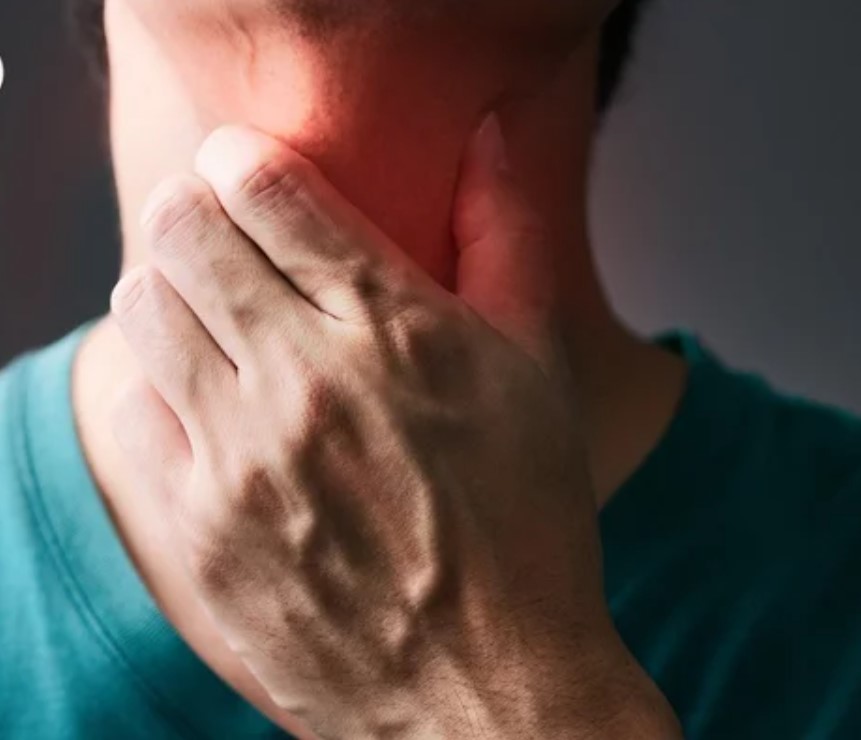A lack of public awareness around throat cancer means only 13 per cent of head and neck cancers are currently diagnosed at an early stage. A fact that Chris Curtis, the founder of The Swallows Head and Neck Cancer Support Group, knows all too well after ignoring his symptoms for weeks. In 2011, the then 51-year-old was diagnosed with stage four oropharyngeal cancer…Click Here To Continue Reading>> …Click Here To Continue Reading>>
“I’d never been a smoker or a drinker, let alone heard of throat
cancer
,” says Curtis. “I had a very small lump on the side of my neck, which had grown very quickly. I went to my GP thinking it was a swollen gland. I realise now I had other symptoms: I was incredibly tired and in bed by 9pm most days; my voice had become very husky. Within two weeks of my first GP appointment, I was diagnosed with stage four cancer at the base of my tongue.”
Head and neck cancer is the more common term used to describe more than 30 areas within the head and neck where cancer can develop, which include in or around the throat and larynx.
According to Cancer Research UK, head and neck cancer is the eighth most common form of cancer in the UK, and it’s two to three times more common in men. About 12,500 new cases are diagnosed each year, with experts warning incidences are on the rise.
Like many serious health conditions, the sooner it is caught, the better it responds to treatment. Here’s everything you need to know about throat cancer.
Jump to:
This refers to all types of cancer that can develop in the throat, known as the pharynx, and also the voice box (larynx). Throat cancer most often begins in the flat cells that line the inside of the throat. The pharynx is a tube that is divided into these main parts:
The larynx (voice box) sits in front of the lower pharynx (hypopharynx), containing vocal cords, and is also susceptible to throat cancer.
There are several different types of throat cancer, listed in order of prevalence:
“The telltale signs are not generally silent but can take a while to be noticed,” warns Dr Naomi Vaughan, a GP with a practice in Harrow, north-west London.
Vaughan says these include:
Dr Vaughan advises anyone living with any, or a combination, of these symptoms for more than three weeks to see a GP, especially if they are a smoker or a drinker.
“If you feel something is not as it should be, speak to your doctor,” says Vaughan, who has been practising for over 20 years. “Working in a medium-sized practice of around 11,500 patients, we refer about eight people a month as suspected head and neck cancers. I can’t give exact figures, but in general about 8-10 per cent of cancer referrals turn out to have cancer.”
Curtis went through radiotherapy,
chemotherapy
and two surgeries. Now, alongside his wife Sharon, he works tirelessly as the chief executive of The Swallows, the Blackpool-based charity he founded in 2012, raising awareness and offering support to thousands across the world.
Curtis survived his stage four cancer diagnosis, but every year 4,100 people die from head and
neck cancer
. That’s 11 every day.
The prognosis is good if diagnosis comes early. “If caught early – stage one or stage two – the five-year survival rate is upwards of 80 per cent,” says Chris Elkington, the chairman of Head and Neck Cancer UK. “If caught at a later stage, this drops to around 50 per cent.”
However, Claire Barber, the chairman of the British Association of Head and Neck Oncology Nurses, and clinical nurse specialist in head, neck and thyroid cancers at the Royal Devon University Healthcare NHS Foundation Trust, has seen great progress in survival rates during her 30-year career.
“When I first started, if anybody had a throat cancer which had spread to another part of the body, such as the lungs, the average length of life was something between nine and 15 months, whereas now patients are living years down the line.”
While scientists and clinicians don’t know exactly what triggers the mutation causing throat cancer, there are READ FULL STORY HERE>>>CLICK HERE TO CONTINUE READING>>>
common risk factors
that can increase chances of developing it. Some major factors are:
“HPV infection is the leading driver in the growing number of diagnoses,” warns Tamara Kahn, the chief executive of Oracle Cancer Trust. “These cancers are presenting in younger people and although historically it has been more men, there are also increasing rates of women also being diagnosed with throat cancers.”
“Twenty years ago we recognised an uptick in oropharyngeal cancer caused by the HPV virus,” explains Prof Vinidh Paleri, a consultant head and neck surgeon at The Royal Marsden Hospitals and director of the International Centre for Recurrent Head and Neck Cancer.
“Studies across America, UK, Europe and other places have shown that between 50 per cent and 90 per cent of cancers in the oropharynx can be caused by the HPV virus. It’s 70 per cent in the UK. Interestingly, this cancer, compared to all other head and neck cancers, seems to arise in the younger, male population. That’s something we didn’t see before.”
Historically, a typical patient was a male smoker or heavy drinker in their 60s or 70s. On the upside, HPV-linked cases generally respond much better to treatment than those that are not HPV-related.
At 43, Jamie Rae was a globetrotting businessman when in May 2010 he was diagnosed with oropharyngeal cancer caused by HPV. After finishing his treatment, Rae launched the Throat Cancer Foundation, campaigning for the HPV vaccine – which has been available to Year 8 girls since 2008 – to be rolled out to schoolboys.
“I never wanted other men to suffer the way I did, so that was my number one objective, to get boys vaccinated,” says Rae.
“It took the best part of six years to convince the Government to do it.”
From September 2019, the vaccine has been offered to Year 8 boys. However, in 2022
will go a long way to eradicating HPV-related cancers and, as Prof Paleri hopes, “eventually getting rid of these tumours by 2060”.
Also, while it’s not always possible to prevent throat cancer, informed lifestyle choices such as quitting smoking, drinking sparingly, eating a healthy diet and taking regular exercise will help.
To check for throat cancer, you may have a:
“This is determined by factors such as staging, location of tumour and a patient’s overall health,” says Barber.
Options include:
Depending on the cancer’s severity, some radical surgeries may be performed, such as:
Prof Paleri is spearheading
transoral robotic surgery
across the UK, a less invasive treatment of head and neck cancers. “The treatments are quite toxic, quite brutal,” he explains. “Any progress we can make to reduce their toxicity is so important and that’s where robotic surgery comes in.”
“Patients often have a very challenging post-treatment quality of life,” says Barber. “Each treatment brings its own set of potential problems and side effects. Some are short-lived, but some never go away. It’s unlike any other cancer because it affects the ability to eat and drink, swallow, talk and communicate.”
Side effects include:
Speech and language therapists help patients relearn how to speak, and swallow safely again. Anxiety and depression commonly extend beyond treatment, and counselling with a dedicated head and neck counsellor or clinical psychologist is advised.
“Some people endure significant weight loss,” Barber explains, “and require tube feeding for many months after treatment.”
“Throat cancer is one of the worst treatment pathways for cancer,” says Curtis. “The only good thing is the majority survive, but we survive with side effects.”


 SPORTS10 months ago
SPORTS10 months ago
 SPORTS10 months ago
SPORTS10 months ago
 SPORTS11 months ago
SPORTS11 months ago
 IN-THE-NEWS6 months ago
IN-THE-NEWS6 months ago
 SPORTS10 months ago
SPORTS10 months ago
 METRO10 months ago
METRO10 months ago
 METRO11 months ago
METRO11 months ago
 IN-THE-NEWS6 months ago
IN-THE-NEWS6 months ago


